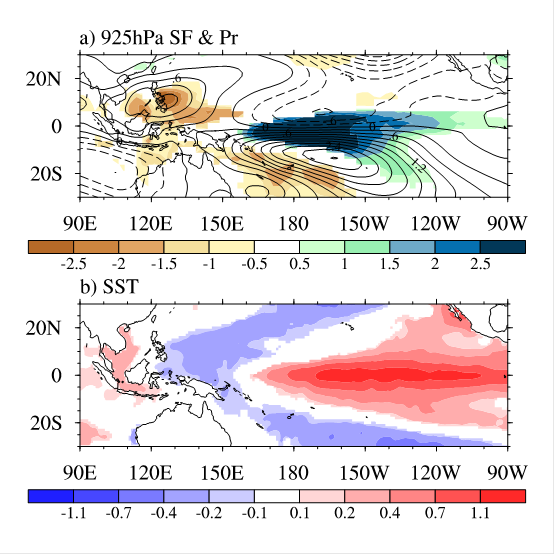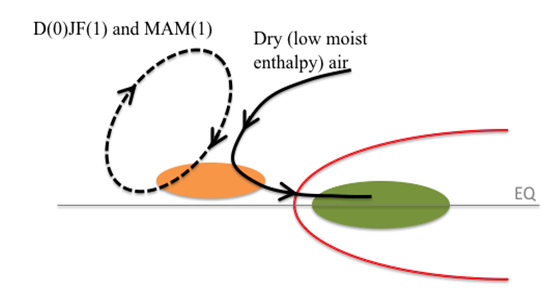State Key Laboratory of Numerical Modeling for Atmospheric Sciences and
Geophysical Fluid Dynamics (LASG)
Institute of Atmospheric Physics, Chinese Academy of Sciences

Vol. 4/No.4 December 2017
[Climate Dynamics] A new mechanism to understand how El Niño influences East Asian and western North Pacific climate
Western North Pacific anomalous anticyclone (WNPAC, or referred to as Philippine Sea anomalous anticyclone) is the most important anomalous circulation pattern connecting El Niño and East Asian-western North Pacific monsoon (Fig. 1). WNPAC maintains from the El Niño mature winter to the following summer and thus is one of the most long-lasting anomalous circulation patterns over the entire tropical climate system. A new mechanism was proposed by Wu et al. (2017a, b) to explain the maintenance of the WNPAC, which was named as “anomalous moist enthalpy advection mechanism”. The mechanism is illustrated by a schematic in Fig. 2. In response to El Niño-related positive precipitation anomalies over the equatorial central-eastern Pacific, twin Rossby-wave cyclonic anomalies are induced to the west. The northern branch of the twin cyclonic anomalies advects dry and low moist enthalpy air into the tropical western North Pacific, which suppresses local convection. The suppressed convection further drives the WNPAC.
Furthermore, the mechanism was applied to explain why the WNPAC forms in the late fall of El Niño developing phase. Three physical processes come into the play. Firstly, meridional gradient of the climatological low-level specific humidity over the WNP changes from positive to negative, which is the necessary condition for the establishment of the negative anomalous moist enthalpy advections. Secondly, meridional gradient of the climatological relative vorticity changes from positive to negative, which causes the decrease of the effective Beta effect. The cyclonic anomalies stimulated by enhanced heating over the equatorial central-eastern Pacific withdraw eastward and thus leave space for the development of the WNPAC. Finally, the cold SST anomalies in the WNP are also important. In no presence of the cold SST anomalies, the onset of the WNPAC would be delayed one month.
Since 2000s, it has been widely accepted that the WNPAC is maintained by the local air-sea interaction via wind-evaporation-SST feedback over the tropical WNP during El Niño mature winter and following spring, which was proposed by Wang et al. (2000). However, some recent studies found that the WNPAC can be simulated by an AGCM, driven by El Niño-related warm SST anomalies in the central-eastern Pacific plus climatological SST in other ocean areas, indicating that the WNPAC can be maintained by an atmospheric bridge from equatorial central-eastern Pacific without the help of local air-sea interactions in the WNP. The contradiction between the leading theory and the AGCM experiments suggests that a new theory is needed to be developed for the maintenance of the WNPAC. The “anomalous moist enthalpy advection mechanism” proposed by Wu et al. (2017a, b) works through pure atmospheric dynamic and thermodynamic processes and does not rely on the local air-sea interactions in the WNP. The Pacemaker experiments further suggested that the contribution of the new mechanism to the WNPAC is somewhat larger than that of the local air-sea interactions.
Furthermore, the new mechanism can be used to explain the formation timing of the WNPAC, which cannot be explained by the previous theories.
CONTACT: Bo Wu, wubo@mail.iap.ac.cn
Reference:
Wu, B., T. Zhou, T. Li, 2017a: Atmospheric dynamic and thermodynamic processes driving the western North Pacific anomalous anticyclone during El Niño. Part I: Maintenance mechanisms, Journal of Climate, 30, 9621-9635.
Wu, B., T. Zhou, T. Li, 2017b: Atmospheric dynamic and thermodynamic processes driving the western North Pacific anomalous anticyclone during El Niño. Part II: Formation processes, Journal of Climate, 30, 9637-9650.

Fig. 1 a) Precipitation (shading) and 925 hPa stream function anomalies (contour, positive values denote anticyclone anomalies) during El Niño mature winter. b) Corresponding SST anomalies.

Fig. 2 Schematic of the anomalous moist enthalpy advection mechanism, which is the most essential forcing mechanism responsible for the maintenance of the WNPAC during El Niño mature winter [D(0)JF(1)] and the following spring [MAM(1)]. Warm SSTAs in the equatorial CEP (red line) enhance local convection (green shading) and thus stimulate cyclonic anomalies to the northwest (black solid line). The northerly component of the western flank of the cyclonic anomalies advects off-equatorial dry (low moist enthalpy) air into the tropical WNP and thus suppresses convection there (orange shading). The suppressed convection further stimulates the WNPAC (black dashed line) to the northwest.
E-mail: lasg_newsletter@lasg.iap.ac.cn
Editors: Chuanyi Wang (wangcy@lasg.iap.ac.cn), Kangjun Chen(ckj@lasg.iap.ac.cn)